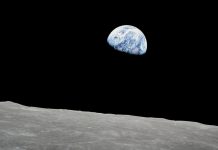
Jan. 26 (UPI) — Earth is set for a very close shave with a small asteroid Thursday just five days after it was discovered by an amateur astronomer in Crimea, according to NASA’s Jet Propulsion Laboratory.
JPL said it expected the asteroid, designated as 2023 BU to streak past 2,200 miles above the southern tip of South America just before 7:30 p.m. EST.
The encounter will be one of the closest approaches by a near-Earth object ever recorded, said the lab.
While there was no possibility of the asteroid, which is believed to be about the size of a box truck measuring between 11.5 and 28 feet across, striking the Earth it will travel well within the orbit of geosynchronous satellites.
If, however, the scientists have miscalculated and the asteroid does enter Earth’s atmosphere, it would turn into a fireball and break up harmlessly, with some of the larger chunks potentially falling as small meteorites, the lab said.
Gennadiy Borisov, who discovered the asteroid from his MARGO observatory in Nauchnyi, Crimea, on Saturday, reported to the International Astronomical Union’s Minor Planet Center which subsequently made it official, following numerous confirmatory sightings by observatories around the world.
The near miss was predicted by a NASA impact assessment system, known as “Scout,” maintained by the Center for Near Earth Object Studies, or CNEOS, at JPL’s lab in Southern California, which tracks the paths of all known objects in the solar system that may pose a hazard.
JPL said that Scout analyzed the data and quickly predicted the near miss.
“Scout quickly ruled out 2023 BU as an impactor, but despite the very few observations, it was nonetheless able to predict that the asteroid would make an extraordinarily close approach with Earth,” said Davide Farnocchia, a navigation engineer at JPL who developed Scout.
“In fact, this is one of the closest approaches by a known near-Earth object ever recorded.”
The asteroid is not Borisov’s only find. He is credited with discovering a rare interstellar comet, 21/Borisov, in 2019.
While Thursday’s visit to Earth is unlikely to be witnessed by many due to the remoteness of the area the asteroid will pass over, it kicks off a bonanza of celestial treats for stargazers to look forward to in coming months.
On Feb. 1, Comet C/2022 E3 (ZTF) will pass at its closest to Earth after an absence of up to 50,000 years, although astronomers recommend first-time comet gazers to look for it on Feb. 10 when it will at its brightest as it nears Mars.
The so-called Green Comet, which scientists believe last appeared in the night sky during the ice age, was discovered in March by astronomers from the Zwicky Transient Facility in southern California.
Then in March, Venus and Jupiter, the two brightest planets, will converge on the first evening of the month, according to AccuWeather. The planets will appear close together in the western sky just after sunset. Venus will be the brighter of the two planets and will shine to the right of Jupiter.
This will be followed by a spectacular Lyrid meteor shower April 22 to April 23 when the so-called Lyrids peak, with up to 20 shooting stars per hour visible.
Astronomers expect near-perfect viewing conditions, cloud cover permitting, as the Lyrids peak two nights after the new moon on April 20, which means that bright moonlight will not overshadow the shooting stars.





